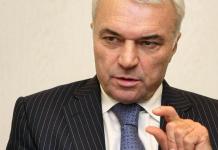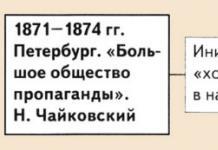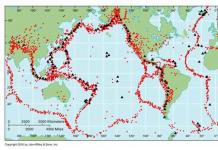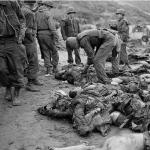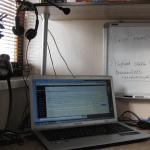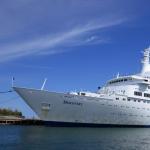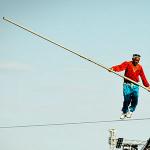Outwardly, it looked like a local conflict, but in essence it was a proxy war between the Soviet and American military-political blocs.
Capitalist countries provided all possible assistance to South Korea.
On North Korea's side were the USSR and China, which did not officially participate in the war; The Chinese military fought on the side of the DPRK under the guise of volunteers, and the USSR provided the Koreans and Chinese with material assistance and supplied them with weapons and ammunition.
Causes of the Korean War
The main prerequisite for the start of the war is the division of the Korean Peninsula. Before Korea was a colony of the Japanese Empire. In this war, Japan sided with Hitler's Germany.
Having declared war on it as the last of the Axis countries, the main countries of the anti-Hitler coalition - the USSR and the USA - began military operations, occupying the Korean Peninsula from different sides.
Japan hastily capitulated, resulting in the formation of two Koreas - “Soviet” and “American”; These countries were independent only formally. It was assumed that such a division would be temporary, but the outbreak of the Cold War changed the situation.
South Korea became a capitalist state, oriented towards the United States, and North Korea - the DPRK - became communist, developing with the support of the Soviet Union.
1. But this situation did not suit the leaders of the two Koreas - Kim Il Sung and Syngman Rhee: each wanted to unite the peninsula under their rule.
2. Another reason is that the North Korean authorities intended to free their capital from capitalist influence: according to the country’s Constitution, the capital of the DPRK was Seoul, located on the territory of South Korea; Pyongyang, according to the plan, was a temporary capital.
3. Finally, the third reason is the desire of world powers to make the Korean Peninsula their strategically important point. It was they who largely led the military operations.
War participants
As already mentioned, the USSR and China fought on the side of the DPRK. The Chinese Peng Dehuai was appointed commander-in-chief of the “volunteer detachments”, under the name of which, in fact, parts of the Chinese army operated. On the side of South Korea, in addition to the United States, there were a number of European and American states, as well as Turkey, the Philippines, Ethiopia, South Africa, Australia and New Zealand.
It is curious that in the United States the conflict in Korea was officially considered not a war, but a police operation, and therefore martial law was not declared in the country. In China, the Korean War is referred to as “a war against America to support the Korean people,” thereby confirming that the main driving forces in the conflict were world powers, and not the Korean authorities and armies.
Progress of the war
The war, however, began suddenly for the world community: on June 25, North Korean troops crossed the border with their southern neighbor. North Korea had significant fighting forces - soldiers trained by Soviet specialists, a huge number of Soviet tanks and aircraft. The army of the southerners was much more modest in number of fighters, and had almost no armored vehicles and aircraft.
On June 28, the northerners captured Seoul, and a little later some other cities. However, Syngman Rhee and a significant number of government members managed to leave the capital; There was no mass uprising of “workers and peasants”, which the DPRK authorities were counting on. There was no lightning victory, despite the fact that the DPRK controlled 90% of the territory of South Korea.
The UN Security Council was urgently convened in New York, by decision of which significant military forces were sent to help South Korea. The UN troops that arrived initially met with setbacks; One of these failures was the capture of the commander of the 24th US Infantry Division, Major General Dean. However, in September 1950, UN troops launched a counteroffensive.
Now the DPRK army was significantly inferior in numbers to international troops. Soon UN forces captured Pyongyang. At first, China did not want to get involved in the conflict. The Chinese government has said the country will enter the war when any non-Korean forces cross the 38th parallel, the border separating North Korea from its southern neighbor.
Harry Truman believed that China was simply threatening the international community, and ordered his troops to cross the border of the DPRK. After which he realized how much he was mistaken: the PRC troops, numbering 270 thousand people, under the leadership of the aforementioned Peng Dehuai, went on the offensive.
The Chinese did not have aircraft; they were armed only with rifles, grenades, mortars and machine guns. However, they chose a winning strategy - they acted at night, attacking small enemy units and winning due to numerical superiority. Moreover, the Soviet Union, which had both planes and tanks, provided more significant support to the North Korean-Chinese troops.
A protracted war began, each side in which acted with varying degrees of success.
Results of the war
- The Korean War was the very first major conflict in the history of the Cold War; starting with it, the confrontation between the two world blocs took on a more acute form.
- The territory of the Korean Peninsula remained divided between two Koreas - capitalist and communist.
- Both countries suffered huge economic losses; roads, residential and government buildings, and enterprises were destroyed.
- Paradoxically, the war turned out to be beneficial for Japan; during the conflict, Americans began to purchase Japanese-made goods and became convinced of their fairly high quality; Soon Japanese zaibatsu (corporations) began to actively move into the world market.
- For the USSR, the war was generally unsuccessful, since it was not possible to create a “friendly” state on the entire Korean Peninsula. However, Soviet officers and military leaders gained significant experience in the war.
Before understanding the results of the Korean War, it is necessary to define the Korean War itself.
The Korean War is an armed conflict between South and North Korea in 1950-1953. The USA, China and the USSR also took part in the conflict.
Results of the Korean War
The Korean War finally divided a united Korea into South and North; after the war, the countries concluded a truce and drew a border dividing the two new states.
Korea
Korea suffered enormous losses, both human and economic. Approximately 80% of all industrial enterprises and transport infrastructures were completely destroyed. Global migration has occurred. Its result was the transfer of more than 2 million people from North Korea. They left the country and went to South Korea.
South Korea's death toll reaches 1 million, and only 20-30% of this number are military personnel. North Korea's death toll is approximately the same; some Western analysts say that North Korea's death toll is greatly underestimated and could reach 1.5 million.
USA
The United States, as a participant in the conflict, lost about 40 thousand of its troops killed. This war showed the United States that its army needed reforms, and they were perfect. Funding for the army has increased significantly, the number of military personnel has doubled, and the number of American bases around the world has increased (Europe, the Middle East, in many regions of Asia). There was a revolution in armaments, many types of weapons became a thing of the past and models such as the M16 or F-6 military fighters appeared.
Racial equalization began in the ranks of the American army, black soldiers began to receive some of the same privileges as the white population. For example, blacks could serve in the same units as whites.
China
The number of injured military personnel of the People's Republic of China, according to various sources, reaches 400 thousand, of which 260 thousand were wounded. Relations between China and the USSR deteriorated greatly. However, the Chinese army inflicted a number of serious defeats on the American army, which made it possible for the USSR to see that a new powerful state was emerging in Asia, whose army should be taken into account.
USSR
For the Soviet Union, this war should not be considered successful. The main goal of the USSR leadership was not achieved; they failed to establish a communist system on the entire Korean Peninsula. The country's economy declined again as it was burdened with heavy military expenses.
But there were also advantages. There has been development in the military field, the creation of new types of weapons has begun. The authority of the USSR increased and the whole world learned that the Union could come to the aid of a developing state.
The Korean War is the first armed conflict of this scale since World War II. This example created a model for a new way of waging war. This conflict also added fuel to the Cold War. Relations between the USA and the USSR finally deteriorated, which seriously affected the further history of the twentieth century.
The Korean War of 1950-1953 was the first local armed conflict between socialist and capitalist states during the Cold War era.
Background to the conflict.
Since 1905, Korea was under the protectorate of Japan, and since 1910 it became its colony and lost its independence. During World War II, fighting with the Japanese army, in August 1945, Soviet troops entered Korean territory from the north, and American forces liberated the country from the south. The demarcation line for them was the 38th parallel, which divided the Korean Peninsula into two parts. Cases of armed clashes and provocations along the 38th parallel became frequent. In 1948, Soviet troops withdrew from Korea, and in June 1949, American forces also left the peninsula, leaving about 500 advisers and weapons.
Formation of states.
After the withdrawal of foreign troops, the country was supposed to be unified, but instead there was a split into two states: the Democratic People's Republic of Korea (DPRK) led by Kim Il Sung in the north and the Republic of Korea led by Syngman Rhee in the south. Both regimes undoubtedly sought to unify the country and made plans that were both political and military in nature. Against the backdrop of regular provocations on the border, at the end of July 1949 a major clash occurred.
The two states played a diplomatic game in order to gain the support of their allies: on January 26, 1950, a Korea-US agreement on mutual defense assistance was signed between the United States and South Korea, and North Korean leader Kim Il Sung negotiated with I.V. Stalin and Chinese leader Mao Zedong, proposing to “probe South Korea with a bayonet.” By this time, the balance of power had undergone significant changes: on August 29, 1949, the USSR conducted its first nuclear weapons test, and in the same year the People's Republic of China (PRC) was formed by the Communists. But even despite this, Stalin continued to hesitate and in a message to Mao Zedong wrote that “the unification plan proposed by the Koreans” was possible only if the Chinese side agreed to support it. The PRC, in turn, expected support from the northerners on the issue of Fr. Taiwan, where supporters of the Kuomintang led by Chiang Kai-shek settled.
Preparation of a military operation by Pyongyang.
By the end of May 1950, Pyongyang had largely completed the development of a strategic plan to defeat the South Korean army in 50 days by launching a sudden and swift attack by two operational army groups in the direction of Seoul and Chunchon. At this time, by order of Stalin, most of the Soviet advisers who had previously been assigned to many North Korean divisions and regiments were recalled, which once again indicates the reluctance of the USSR to start a war. The Korean People's Army (KPA) of the DPRK had up to 188 thousand soldiers and officers, the army of the Republic of Korea - up to 161 thousand. In terms of tanks and self-propelled guns, the KPA had a superiority of 5.9 times.
Escalation of the conflict.
In the early morning of June 25, 1950, North Korean troops moved to the south of the country. It was officially stated that the southerners were the first to open fire, and the North Koreans repulsed the attack and launched their own offensive. In just three days they managed to capture the capital of the South - Seoul, and soon they captured almost the entire peninsula and came close to its southern tip - the city of Busan, which was held by parts of the southerners. During the offensive, the North Koreans carried out land reform in the occupied territories, based on the principles of free transfer of land to peasants, and also created people's committees as local government bodies.
From the first day of the war, the United States began to actively assist its South Korean ally. Since the beginning of 1950, the USSR boycotted meetings of the UN Security Council in protest against the participation of a representative of Taiwan in it instead of the legal representative of the PRC, which the United States did not fail to take advantage of. At an urgently convened meeting of the UN Security Council on June 25, a resolution was adopted expressing “serious concern” about the attack by North Korean troops on the Republic of Korea, and on June 27 a resolution followed condemning the “invasion” of the DPRK and calling on UN members to provide the Republic of Korea with comprehensive military assistance for repelling the offensive operations of North Korean troops, which actually freed the hands of the American army, which was joined, albeit in small numbers, by troops of other states, while having the status of “UN armed forces.” American General D. MacArthur was appointed Commander-in-Chief of the UN forces in Korea, who simultaneously led the South Korean troops.
On the strategic bridgehead of Busan-Daegu, the Americans in a short time managed to concentrate armed forces that were more than 2 times larger than the sprawling 70,000-strong army group of the northerners. But even under these conditions, North Korean troops managed to advance 10-15 km, but on September 8 their offensive finally stopped. On September 13, 1950, the Pentagon began a large-scale landing of almost 50,000 troops, equipped with tanks, artillery, supported by the Navy and aviation (up to 800 aircraft) near Inchon. They were opposed by a garrison of 3 thousand people, who showed unprecedented resilience in repelling the landing. After this landing operation, the North Korean troops were actually surrounded.
Second stage of the war.
The next period of the war was characterized by the same rapid advance of UN troops and South Koreans into the north of the Korean Peninsula as was the advance of North Korean troops in the first months of the war. At the same time, some of the northerners fled in disarray, the rest were surrounded, many of them switched to guerrilla warfare. The Americans occupied Seoul, crossed the 38th parallel in October, and soon approached the western part of the Korean-Chinese border near the city of Chosan, which was perceived as an immediate threat to the PRC, since American military aircraft repeatedly invaded Chinese airspace. North Korea found itself on the brink of a complete military catastrophe, clearly not ready for long-term hostilities and confrontation with the US army.
However, at this time events took a new turn. Chinese “people's volunteers” numbering about a million people, who are career military personnel, entered the war. They were led by the famous military leader Peng Dehuai. The Chinese had virtually no aircraft or heavy equipment, so they used special tactics in battles, attacking at night and sometimes gaining the upper hand due to heavy losses and superior numbers. To help the allies, the USSR transferred several air divisions to cover the offensive from the air. In total, during the war, Soviet pilots shot down about 1200-1300 American aircraft, their own losses were over 300 aircraft. There was also a supply of equipment that was urgently needed by both the North Koreans and the Chinese. To coordinate actions, a Unified Command was created headed by Kim Il Sung. His main adviser was the Soviet Ambassador, Lieutenant General V.I. Razuvaev. From the first days, the combined North Korean and Chinese troops launched a counter-offensive, and in the course of two offensive operations, not without the help of units remaining in the rear of the “UN troops,” they managed to take Pyongyang and reach the 38th parallel.
To consolidate the success, a new offensive operation was launched on December 31 (December 31 - January 8, 1951), which culminated in the capture of Seoul. But the success was short-lived, and by March the city was recaptured; as a result of the successful offensive of the southerners, the front lined up along the 38th parallel by June 9, 1951. The success of the American troops was explained by the serious superiority in artillery and aviation, which carried out continuous attacks. At the same time, the Americans deployed a third of their ground forces, one-fifth of their aviation and most of their naval forces. During this period of the campaign, D. MacArthur, the commander-in-chief of the UN forces in Korea, insisted on expanding the scale of the war, proposed launching military operations in Manchuria, involving Chiang Kai-shek's Kuomintang army (located in Taiwan) in the war, and even launching a nuclear strike on China.
The USSR was also preparing for the worst-case scenario: in addition to the Soviet pilots and specialists who fought on the fronts, five Soviet armored divisions stood ready on the border with the DPRK, and the Pacific Fleet was on high alert, including warships in Port Arthur. However, prudence prevailed, the US government rejected D. MacArthur’s proposal, which threatened the Sami with dangerous consequences and removed him from command. By this time, any offensive by one of the warring parties had become practically impossible; the northern troops had a clear advantage in numbers, and the southern troops had a clear advantage in technology. Under these conditions, after the hardest fighting and numerous losses, a further war for the two sides would be accompanied by even greater losses.
Conflict resolution.
In the summer of 1951, both sides decided to begin peace negotiations, which were interrupted at the initiative of South Korea, dissatisfied with the existing front line. Soon there were two unsuccessful offensive attempts by South Korean-American troops: in August and September 1951, with the goal of breaking through the northern defense line. Then both sides decided to resume peace negotiations. The venue was Panmunjom, a small point in the western part of the front line. Simultaneously with the start of negotiations, both sides began construction of defensive engineering structures. Since most of the front line, central and eastern, lay in mountainous terrain, North Korean and Chinese People's Volunteer troops began constructing tunnels that served as the best defense against American air raids. In 1952 and 1953 Several more major military clashes between the two sides took place.
Only after the death of I.V. Stalin, when the Soviet leadership decided to abandon such active support for North Korea, both sides decided to begin final negotiations. By July 19, 1953, a unity of opinions was achieved on all points of the future agreement. On July 20, work began to determine the location of the demarcation line, and on July 27, 1953, at 10 a.m., an Armistice Agreement was finally signed in Panmunjom. It was signed by representatives of the three main warring parties - the DPRK, the People's Republic of China and the UN troops and declared a ceasefire. South Korea refused to sign the agreement, but was ultimately forced to agree under pressure from the United States, which signed the Mutual Security Treaty of October 1, 1953, as well as the Memorandum of Agreement on Military and Economic Assistance of November 14, 1954 , according to which a 40,000-strong American contingent remained in South Korea.
Losses of the parties.
A very high price was paid for the fragile peace and the right of the DPRK and the Republic of Korea to continue building their type of society. During the war years, the total number of dead reached 1.5 million people, and the wounded - 360 thousand, many of whom remained crippled for life. North Korea was completely destroyed by American bombing: 8,700 industrial enterprises and more than 600 thousand residential buildings were destroyed. Although there were no such large-scale bombings on South Korean territory, there was also quite a lot of destruction during the war. During the war, there were frequent cases of war crimes, mass executions of prisoners of war, wounded and civilians on both sides.
According to the official publication of the USSR Ministry of Defense, during the Korean War, Soviet air units lost 335 aircraft and 120 pilots in combat battles with US aviation. The total losses of Soviet units and formations officially amounted to 299 people, including 138 officers and 161 sergeants and soldiers. The irretrievable losses of UN troops (primarily the United States) amounted to more than 40 thousand people. Data on Chinese losses vary from 60 thousand to several hundred thousand people.
The Korean War had great negative consequences for all parties to the conflict, and became the first armed local conflict between two superpowers that used all types of weapons except nuclear weapons. The process of normalization of relations between the USA and the USSR after the Korean War could not be either quick or simple.
The Korean War of 1950-1953 is usually called a local military conflict between two opposing parts of what was once one country, which was divided after World War II into South and North Korea. In fact, it was a proxy war, waged by two military-political systems - the “Soviet” and the “American” - at the hands of the Korean people. Pro-communist North Korea was supported by the USSR and China, whose participation in this conflict was unofficial. UN peacekeeping forces took part in the fighting on the side of South Korea.
In Pyongyang this war is called the Fatherland Liberation War, and in Seoul it is called the “Troubles or June 25 Incident.”
This military conflict, which happened more than half a century ago, has not officially ended, since there have been no announcements about its end. And the confrontation between the two Koreas continues to this day.
Reasons that led Korea to war
It was possible to foresee such a development of events back in the summer of 1945, when soldiers of the USSR and US armies appeared on the territory of the Korean Peninsula. And after World War II ended, and the peninsula was temporarily divided into northern and southern parts along the 38th parallel, the confrontation between them became more and more noticeable, although it was assumed that over time Korea should become a single country. But the Cold War began, and in the context of the confrontation between two opposing world systems, it became almost impossible to agree on reunification. Therefore, North Korea developed under the patronage of the Soviet Union and became a communist country, while South Korea was more oriented toward the United States and followed the capitalist path of development. But both General Secretary Kim Il Sung and President Syngman Rhee sought unification, but each saw a unified Korea under their own leadership. And at the same time, both leaders understood that they could not do without the use of force, so they prepared for war.

Seoul and Pyongyang were also prompted to take military action by the political situation in the world: the worsening of the Cold War, the emergence of Soviet nuclear weapons, and the creation of the People's Republic of China. Well, the most important reason for the war was the intervention of the world's powerful powers in the internal affairs of Korea in order to pursue their policies on the Korean Peninsula.
Progress of the war
Until 1950, Soviet and American troops left the territory of the peninsula, leaving behind not only military equipment, but also their military advisers.
Skirmishes along the demarcation line between the two Koreas occurred regularly, and the situation remained extremely tense until June 25, 1950, when it escalated into an armed conflict, which began with a surprise offensive by North Korean troops.
The UN Security Council discussed the Korean issue on the same day, and as a result, they came to an agreement to provide military assistance to South Korea, and North Korea was obliged in an ultimatum to withdraw its military forces from the southern territories. Such decisions were made because at that time the representative from the Soviet Union refused to participate in meetings of the Security Council and was unable to use the right of veto.
On June 27, American air and naval forces, and on July 1, ground forces arrived to participate in the Korean War. In addition to the United States, military formations of 16 more states entered into hostilities.
Initially, the North Korean army was very successful and managed to put South Korean troops and peacekeeping forces to flight. The northerners successfully carried out military operations in the area of Suwon, Seoul, Naktogang, Daejeon and Busan and as a result occupied most of South Korean territory. Enemy troops were pinned to the sea near the port of Busan.

The Supreme Commander-in-Chief of the peacekeeping forces in Korea, General Douglas MacArthur, not only managed to competently organize the defense of the port of Busan, but also carried out a counter-offensive with the landing of American troops in the port of Inchon. On September 15, Incheon was taken, and the combined forces of UN peacekeepers and the South Korean army, successfully moving forward, recaptured previously lost territories. North Korean troops were driven back all the way to the border with China. This meant that the entire territory of the Korean Peninsula could be occupied by American and South Korean forces. Therefore, in order to prevent such a development of events, the Soviet Union and China decided to come to the aid of their ally. And by the beginning of November, Chinese troops (they were called “Chinese people’s volunteers”) and Soviet MiG-15 fighters found themselves on Korean territory.
Until January 1951, military operations proceeded with varying success, but neither side achieved significant results. By July 1951, enemy troops took up positions approximately at the 38th parallel, that is, they found themselves where the war began a year ago.
In July 1951, opponents started talking about a truce. Although negotiations began, the fighting continued. Now the fighting moved into the air, where American and Soviet pilots competed.
In the spring of 1953, I.V. Stalin died, and the USSR decided that the time had come to end this war. Without the help of the Soviet Union, North Korea did not dare to continue hostilities.
Therefore, already on July 27, 1953, in the village of Panmunjom on the border of North and South Korea, an agreement was signed to cease hostilities, which, in essence, meant the end of the Korean War. According to this agreement, a 4 km neutral demilitarized strip was established between the two states, and the rules for the return of prisoners of war were determined.
Results
In this war, both sides suffered huge human losses. More than 1.5 million people were killed or wounded among those who fought on the side of North Korea, including about 900 thousand Chinese. Southern losses reached almost a million people, more than 150 thousand of whom were Americans. Losses among the civilian population of the Korean Peninsula reached about 3 million people.
In addition to the loss of life, Korean industry was also affected, 80% of which was destroyed. As a result, the entire peninsula was on the verge of a humanitarian catastrophe.
In 1945 it was a colony of Japan. On August 6, 1945, the Soviet Union, in accordance with the agreement concluded with the United States, denounced the 1941 non-aggression pact, declared war on the Empire of Japan, and on August 8, Soviet troops entered Korea from the north. American troops landed on the Korean Peninsula from the south.
On August 10, 1945, in connection with the inevitable Japanese surrender, the United States and the USSR agreed to divide Korea along the 38th parallel, assuming that Japanese troops north of it would surrender to the Red Army, and the United States would accept the surrender of the southern formations. The peninsula was thus divided into northern, Soviet, and southern, American parts. It was assumed that this separation was temporary.
In December 1945, the USA and the USSR signed an agreement on the temporary administration of the country. Governments were formed in both parts, northern and southern. In the south of the peninsula, the United States, with UN support, held elections, replacing the left-wing provisional government convened in June 1945 after the war with an anti-communist one led by Syngman Rhee. Left parties boycotted these elections. In the north, power was transferred by Soviet troops to the communist government led by Kim Il Sung. The countries of the anti-Hitler coalition assumed that after some time Korea should reunite, but in the context of the beginning of the Cold War, the USSR and the USA could not agree on the details of this reunification, therefore, in 1947, the United Nations, at the instigation of US President Truman, without relying on any referendums and plebiscites, took responsibility for the future of Korea.
Both South Korean President Syngman Rhee and North Korean Workers' Party General Secretary Kim Il Sung made no secret of their intentions: both regimes sought to unite the peninsula under their leadership. The Constitutions of both Korean states, adopted in 1948, clearly stated that the goal of each of the two governments was to extend its power throughout the country. It is significant that in accordance with the North Korean Constitution of 1948, Seoul was considered the capital of the country, while Pyongyang was, formally, only the temporary capital of the country, in which the highest authorities of the DPRK were located only until the “liberation” of Seoul. Moreover, by 1949, both Soviet and American troops were withdrawn from Korean territory.
The PRC government was anxiously following the escalating situation in Korea. Mao Zedong was convinced that American intervention in Asia would destabilize the region and adversely affect his plans to defeat Chiang Kai-shek's Kuomintang forces based in Taiwan. Beginning in early 1949, Kim Il Sung began to approach the Soviet government with requests for assistance in a full-scale invasion of South Korea. He emphasized that Syngman Rhee's government was unpopular and argued that an invasion by North Korean troops would lead to a mass uprising in which South Koreans, working with North Korean units, would themselves overthrow the Seoul regime.
Stalin, however, citing the insufficient degree of readiness of the North Korean army and the possibility of US troops interfering in the conflict and unleashing a full-scale war using atomic weapons, chose not to satisfy these requests of Kim Il Sung. Most likely, Stalin believed that the situation in Korea could lead to a new world war. Despite this, the USSR continued to provide North Korea with large amounts of military assistance. North Korea, in response to South Korea's armament, also continued to increase its military power, organizing its army along the Soviet model and under the leadership of Soviet military advisers. A major role was also played by ethnic Koreans from China, veterans of the People's Liberation Army of China, who, with the consent of Beijing, joined the North Korean armed forces. Thus, by early 1950, the North Korean armed forces were superior to the South Korean ones in all key components. Finally, in January 1950, after considerable hesitation and succumbing to the persistent assurances of Kim Il Sung, Stalin agreed to carry out a military operation. Details were agreed upon during Kim Il Sung's visit to Moscow in March–April 1950, and the final offensive plan was prepared by Soviet advisers by the end of May.
On January 12, 1950, US Secretary of State Dean Acheson announced that the American defense perimeter in the Pacific Ocean ran through the Aleutian Islands, the Japanese Ryukyu Islands and the Philippines, which indicated that Korea was not within the sphere of immediate US government interests. This fact added to the resolve of the North Korean government to start an armed conflict, and helped convince Stalin that US military intervention in the Korean conflict was unlikely.
The forerunner of the Korean War is the so-called. the “small war” of 1949-1950, which consisted of a series of “incidents” in the area of the 38th parallel from both the DPRK and the Republic of Korea.
The largest of them can be considered the conflict over height 488.2 (Mount Songak), Hwanghae Province (May-July 1949), in the Gacheon Township of Paeksong County, Hwanghae Province (May 21-June 7), the invasion of South Korean troops in the Yanyan region of Gangwon Province (late June-July 1949), the conflict around Mount Eunpa, Hwanghae Province (July-October 1949), the incident in Mongimpo Bay (August 6, 1949) and a number of others.
In addition, reconnaissance and sabotage groups were constantly sent to areas north and south of the 38th parallel during 1949 and early 1950 with the aim of carrying out subversive, sabotage and terrorist acts and intimidating civilians.
In the pre-dawn hours of June 25, North Korean troops, under the cover of artillery, crossed the border with their southern neighbor. The size of the ground force, trained by Soviet military advisers, was 135 thousand people, and it included 150 T-34 tanks. On the South Korean side, the size of the ground force, trained by American specialists and armed with American weapons, was about 150 thousand people at the beginning of the war; The South Korean army had almost no armored vehicles or aircraft. The North Korean government said that "traitor" Rhee Syngman treacherously invaded North Korean territory. The advance of the North Korean army in the early days of the war was very successful. Already on June 28, the capital of South Korea, the city of Seoul, was captured. The main attack directions also included Kaesong, Chuncheon, Uijongbu and Onjin. Seoul Gimpo Airport was completely destroyed. However, the main goal was not achieved - there was no lightning victory; Syngman Rhee and a significant part of the South Korean leadership managed to escape and leave the city. The mass uprising that the North Korean leadership was counting on also did not happen. However, by mid-August, up to 90% of the territory of South Korea was occupied by the DPRK army.
The outbreak of the Korean War came as a surprise to the United States and other Western countries: just a week before, on June 20, Dean Acheson from the State Department stated in his report to Congress that war was unlikely. Truman was informed about the start of the war a few hours after it began, due to the fact that he went to his homeland in Missouri for the weekend, and US Secretary of State Atchison went to Maryland. On the other hand, there is evidence that the start of the war was planned in advance, so the United States began evacuating its citizens as early as June 24.
Despite the post-war demobilization of the US Army, which significantly weakened its strength in the region (with the exception of the US Marine Corps, the divisions sent to Korea were at 40% strength), the US still maintained a large military contingent under the command of General Douglas MacArthur in Japan. With the exception of the British Commonwealth, no other country had such military power in the region. At the beginning of the war, Truman ordered MacArthur to provide military equipment to the South Korean army and carry out the evacuation of US citizens under air cover. Truman did not heed the advice of his circle to start an air war against the DPRK, but ordered the Seventh Fleet to ensure the defense of Taiwan, thus ending the policy of non-intervention in the struggle of the Chinese Communists and the forces of Chiang Kai-shek. The Kuomintang government, now based in Taiwan, asked for military assistance, but the US government refused, citing the possibility of interference in the conflict by Communist China.
On June 25, the UN Security Council convened in New York, with the Korean issue on its agenda. The original resolution proposed by the Americans was adopted with nine votes in favor and no votes against. The representative of Yugoslavia abstained, and the Soviet ambassador Yakov Malik did not appear for the decisive vote due to the lack of clear instructions from Moscow. According to other sources, the USSR did not participate in the vote on the Korean problem, since by that time it had withdrawn its delegation in protest against the non-admission of Chinese representatives to the UN.
Other Western powers sided with the United States and provided military assistance to American troops who were sent to help South Korea. However, by August, Allied forces were driven far south to the Busan area. Despite the arrival of assistance from the UN, American and South Korean troops were unable to escape the encirclement known as the Busan Perimeter; they were only able to stabilize the front line along the Naktong River. It seemed that it would not be difficult for the DPRK troops to eventually occupy the entire Korean Peninsula. However, the Allied forces managed to go on the offensive by the fall.
The most important military operations in the first months of the war were the Daejeon offensive operation (July 3-25) and the Naktong operation (July 26-August 20). During the Daejeon operation, in which several infantry divisions of the DPRK army, artillery regiments and some smaller armed formations took part, the northern coalition managed to immediately cross the Kimgan River, encircle and dismember into two parts the 24th American Infantry Division and capture its commander , Major General Dean. As a result, American troops lost 32 thousand soldiers and officers, more than 220 guns and mortars, 20 tanks, 540 machine guns, 1300 vehicles, etc. During the Naktong operation in the Naktong River area, significant damage was caused to the 25th Infantry and 1st Cavalry Divisions Americans, in the southwestern direction, the 6th Infantry Division and the motorcycle regiment of the 1st Army of the KPA defeated the retreating units of the South Korean army, captured the southwestern and southern parts of Korea and reached the approaches to Masan, forcing the 1st American Division to retreat to Busan Marine Corps. On August 20, the North Korean offensive was stopped. The Southern Coalition retained the Busan bridgehead up to 120 km along the front and up to 100-120 km in depth and defended it quite successfully. All attempts by the DPRK army to break through the front line were unsuccessful.
Meanwhile, in early autumn, southern coalition troops received reinforcements and began attempts to break through the Busan perimeter.
Counter-offensive of the Southern Coalition troops (September-November 1950)
The counteroffensive began on September 15. By this time, in the Busan perimeter there were 5 South Korean and 5 American divisions, a brigade of the British Army, about 500 tanks, over 1,634 guns and mortars of various calibers, and 1,120 aircraft. From the sea, the group of ground forces was supported by a powerful group of US Navy and allies - 230 ships. They were opposed by 4 thousand soldiers of the DPRK army, with 40 tanks and 811 guns.
Having ensured reliable protection from the south, on September 15, the southern coalition launched Operation Chromite. During its course, American troops landed in the port of Incheon near Seoul. The landing was carried out in three echelons: in the first echelon - the 1st Marine Division, in the second - the 7th Infantry Division, in the third - a special forces detachment of the British Army and some units of the South Korean army. The next day, Incheon was captured, the landing troops broke through the defenses of the North Korean army and launched an offensive towards Seoul. In the southern direction, a counteroffensive was launched from the Daegu area by a group of 2 South Korean army corps, 7 American infantry divisions and 36 artillery divisions. Both attacking groups united on September 27 near Yesan County, thus encircling the 1st Army Group of the DPRK Army. The next day, UN forces captured Seoul, and on October 8 they reached the 38th parallel. After a series of battles in the area of the former border of the two states, the forces of the southern coalition again went on the offensive towards Pyongyang on October 11.
Although the northerners, at a feverish pace, built two defensive lines at a distance of 160 and 240 km north of the 38th parallel, they clearly did not have enough forces, and the divisions that completed the formation did not change the situation. The enemy could conduct hourly or daily artillery bombardment and airstrikes. To support the operation to capture the capital of the DPRK, on October 20, 5,000 airborne troops were dropped 40-45 kilometers north of the city. The capital of the DPRK has fallen.
Intervention by China and the USSR (October 1950)
By the end of September, it became clear that the North Korean armed forces were defeated, and that the occupation of the entire territory of the Korean Peninsula by American and South Korean troops was only a matter of time. Under these conditions, active consultations between the leadership of the USSR and the PRC continued throughout the first week of October. In the end, the decision was made to send parts of the Chinese army to Korea. Preparations for such an option had been going on since the late spring of 1950, when Stalin and Kim Il Sung informed Mao of the impending attack on South Korea.
The PRC leadership has publicly stated that China will enter the war if any non-Korean military forces cross the 38th parallel. The corresponding warning was, in particular, transmitted through the Indian ambassador to the PRC in early October. However, President Truman did not believe in the possibility of large-scale Chinese intervention, stating that Chinese warnings were only "attempts to blackmail the UN."
The very next day after American troops crossed the border into North Korea on October 8, 1950, Chairman Mao ordered the Chinese army to approach the Yalu River and be ready to cross it. “If we allow the United States to occupy the entire Korean Peninsula, we must be prepared for them to declare war on China,” he told Stalin. Premier Zhou Enlai was urgently sent to Moscow to convey Mao's views to the Soviet leadership. Mao, awaiting help from Stalin, delayed the date of entry into the war by several days, from October 13 to October 19.
However, the USSR limited itself to air support, and the Soviet MiG-15s were not supposed to fly closer than 100 km to the front line. New jet aircraft prevailed over the outdated American F-80 until more modern F-86 aircraft appeared in Korea. The military assistance provided by the USSR to the United States was well known, but in order to avoid an international nuclear conflict, no retaliatory measures were necessary from the Americans. At the same time, throughout the entire period of hostilities, Soviet representatives publicly and officially assured that “there are no Soviet pilots in Korea.”
On October 15, 1950, Truman traveled to Wake Atoll to discuss the possibility of Chinese intervention and measures to limit the scope of the Korean War. There, MacArthur convinced Truman that “if the Chinese try to enter Pyongyang, there will be a big chop there.”
China could wait no longer. By mid-October, the issue of the entry of Chinese forces into the war was resolved and agreed upon with Moscow. The offensive of the 270,000-strong Chinese army under the command of General Peng Dehuai began on October 25, 1950. Taking advantage of the effect of surprise, the Chinese army crushed the defenses of the UN troops, but then retreated into the mountains. Chinese losses amounted to 10,000 people, but the American Eighth Army also lost almost 8,000 people (of which 6,000 were Koreans) and was forced to take up defensive positions along the southern bank of the Han River. UN troops, despite this blow, continued their offensive towards the Yalu River. At the same time, in order to avoid formal conflicts, the Chinese units operating in Korea were called “Chinese people’s volunteers.”
At the end of November, the Chinese launched a second offensive. To lure the Americans out of strong defensive positions between Hangang and Pyongyang, Peng ordered his units to feign panic. On November 24, MacArthur sent Southern divisions straight into the trap. Having bypassed the UN troops from the west, the Chinese surrounded them with an army of 420,000 and launched a flank attack on the American Eighth Army. In the east, in the Battle of Chhosin Reservoir (November 26 - December 13), a regiment of the US 7th Infantry Division was defeated. The Marines fared somewhat better: despite being forced to retreat south, the 1st Marine Division defeated seven divisions of the Chinese, who had engaged two armies from the Ninth Army Group in the fight against the American Marines.
In northeast Korea, UN forces retreated to the city of Hungnam, where, having built a defensive line, they began evacuation in December 1950. About 100 thousand military personnel and the same number of civilians from North Korea were loaded onto military and commercial ships and successfully transported to South Korea.
On January 4, 1951, the DPRK, in alliance with China, captured Seoul. The US 8th Army and 10th Corps were forced to retreat. General Walker, who died in a car accident, was replaced by Lieutenant General Matthew Ridgway, who commanded the airborne forces during World War II. Ridgway immediately set about strengthening the morale and fighting spirit of his soldiers, but the situation for the Americans was so critical that the command was seriously thinking about using nuclear weapons. Timid attempts at a counteroffensive, known as Operations Wolf Hunt (late January), Operation Thunder (began January 25), and Operation Encirclement, were unsuccessful. However, as a result of the operation, which began on February 21, 1951, UN troops managed to significantly push the Chinese army to the north. Finally, on March 7, the order was given to begin Operation Ripper. Two directions of counteroffensive were chosen in the central part of the front line. The operation progressed successfully, and in mid-March the troops of the southern coalition crossed the Han River and occupied Seoul. However, on April 22, the troops of the North launched their counteroffensive. One strike was carried out on the western sector of the front, and two auxiliary strikes were carried out in the center and in the east. They broke through the UN line, divided the American forces into isolated groups and rushed towards Seoul. The 29th British Brigade, which was occupying a position along the Imjingan River, was in the direction of the main attack. Having lost more than a quarter of its personnel in the battle, the brigade was forced to retreat. In total, during the offensive from April 22 to 29, up to 20 thousand soldiers and officers of American and South Korean troops were wounded and captured.
On April 11, 1951, by order of Truman, General MacArthur was removed from command of the troops. There were several reasons for this, including MacArthur's diplomatic meeting with Chiang Kai-shek, the erratic conduct of military operations, and the unreliable information he conveyed to Truman at Wake Atoll about the number of Chinese troops near the Korean border. In addition, MacArthur openly insisted on a nuclear strike on China, despite Truman's reluctance to extend the war from the Korean Peninsula and the possibility of a nuclear conflict with the USSR. Truman was not happy with MacArthur taking on powers that belonged to the Supreme Commander, who was Truman himself. The military elite fully supported the president. MacArthur was replaced by the former commander of the 8th Army, General Ridgway, and Lieutenant General Van Fleet became the new commander of the Eighth Army.
On May 16, the next offensive of the northern coalition troops began, quite unsuccessfully. It was stopped on May 21, after which UN troops launched a full-scale offensive along the entire front. The army of the North was thrown back beyond the 38th parallel. The southern coalition did not develop its success, limiting itself to reaching the lines it occupied after Operation Ripper.
End of hostilities
By June 1951 the war had reached a critical point. Despite heavy losses, each side had an army of about a million people. Despite their superiority in technical means, the United States and its allies were unable to achieve a decisive advantage. The issue of using nuclear weapons in the theater of military operations was considered by the Americans more than once, but each time the conclusion was made that they were ineffective. It became clear to all parties to the conflict that it would be impossible to achieve a military victory at a reasonable cost and that negotiations on a truce were necessary. The parties first sat down at the negotiating table in Kaesong on July 8, 1951, but even during the discussions, fighting continued.
The purpose of the so-called The "UN force" was the restoration of South Korea to pre-war limits. The Chinese command put forward similar conditions. Both sides supported their demands with bloody offensive operations. Thus, during the offensive of August 31 - November 12, 1951, the Eighth Army lost 60,000 people, of which 22,000 were Americans. In late November, the Chinese launched a counteroffensive, suffering over 100,000 casualties. Despite the bloodiness of the fighting, the final period of the war was characterized by only relatively minor changes to the front line and long periods of discussion about the possible end of the conflict.
By the beginning of winter, the main subject of negotiations was the repatriation of prisoners of war. The communists agreed to voluntary repatriation with the condition that all North Korean and Chinese prisoners of war would be returned to their homeland. However, when interviewed, many of them did not want to return. In addition, a significant portion of North Korean prisoners of war were actually South Korean citizens who fought for the North under duress. To disrupt the process of weeding out “refuseniks,” the Northern coalition sent its agents into South Korean prisoner-of-war camps to provoke unrest.
Dwight Eisenhower, elected President of the United States on November 4, 1952, even before officially taking office, traveled to Korea in order to find out on the spot what could be done to end the war. However, the turning point was the death of Stalin on March 5, 1953, shortly after which the Politburo of the Central Committee of the All-Union Communist Party of Bolsheviks voted to end the war. Having lost support from the USSR, China agreed to the voluntary repatriation of prisoners of war, subject to the screening of “refuseniks” by a neutral international agency, which included representatives of Sweden, Switzerland, Poland, Czechoslovakia and India. On April 20, 1953, the exchange of the first sick and maimed prisoners began.
After the UN accepted India's ceasefire proposal, a ceasefire agreement was concluded on July 27, 1953. It is noteworthy that representatives of South Korea refused to sign the document, so all the so-called. The “UN forces” were represented by the commander of the American contingent, General Clark. The front line was fixed in the area of the 38th parallel, and a demilitarized zone (DMZ) was proclaimed around it. This territory is still guarded by North Korean troops from the north and American-Korean troops from the south. The DMZ runs slightly north of the 38th parallel in its eastern part and slightly south in the west. The site of the peace talks, Kaesong, the old capital of Korea, was part of South Korea before the war, but is now a city with special status for the DPRK. To this day, a peace treaty that would formally end the war has not been signed.
